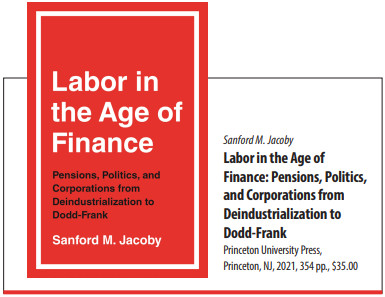IN THE 1970s, labor activists came to believe that if US unions mobilized the enormous latent financial leverage in the growing pension funds they had won for their members, they might transform American capitalism, using labor’s investing power to modify corporate behavior. Nor were activists the only believers. Even management guru Peter Drucker predicted that “the accumulation of pension assets would bring socialism to the United States.” In this fine book, the first history of US labor’s foray into capital strategies, economic historian Sanford M. Jacoby explains why such grand dreams never materialized.
Jacoby’s narrative shows how a combination of obstacles, contradictions, and unintended consequences limited unions’ capital strategies. One obstacle was the fiduciary duty of union pension fund trustees to maximize returns on investments in order to ensure secure retirements for union members. The more union membership shrank after the 1970s, the fewer the number of unionized employers who paid into pension funds, creating increasing pressure on trustees to maximize returns. This surfaced a contradiction: pensioners’ interests did not align neatly with those of active workers and unions. Indeed, ensuring pensioners’ retirement security could conflict with activist investing to an extent that neither labor activists nor Drucker had anticipated.
Yet Jacoby’s most interesting tale concerns unintended consequences as revealed in the experience of the nation’s largest public employee pension fund, the California Public Employees’ Retirement System (CalPERS). CalPERS pioneered the strategy for labor’s activist investors by codifying a set of principles of corporate governance in the 1990s that Jacoby calls the “cookbook.” CalPERS and other pension funds alleged that corporations were poorly run and failed to maximize shareholder value because executives so thoroughly dominated their compliant corporate boards. In response, the funds pooled their influence to advance the cookbook’s principles: limits on CEO pay, board member independence from CEOs, and greater transparency in corporate financing.
That approach, Jacoby shows, yielded decidedly mixed results. Pension fund activism failed to narrow the growing compensation gap between executives and their employees. Instead, it helped shift executive compensation from salary toward stock options. Stock options in turn incentivized executives to downsize and outsource work as means of inflating stock prices (and their incomes). Meanwhile, the pension funds’ embrace of shareholder activism further legitimized the “shareholder value” worldview that gripped the nation’s equity markets.
There were bright spots of financial activism, to be sure, Jacoby notes. Some unions—such as the Service Employees International Union, through its Justice for Janitors campaign—were able to deploy labor’s financial leverage to achieve breakthroughs. Overall, though, the achievements of labor’s financial strategies fell far short of grand 1970s dreams. How far short was revealed by the 2008 crash; the Great Recession; and the 2010 Dodd-Frank financial regulation legislation, which largely failed to rectify the dysfunction that labor had fought for decades to correct.
This smart and sober volume is unsurpassed as a starting point for anyone who seeks to understand both the urgent necessity and the enormous difficulty of making financial markets more accountable to the common good.
Opinions expressed in articles and other materials are those of the authors; they do not necessarily reflect IMF policy.









